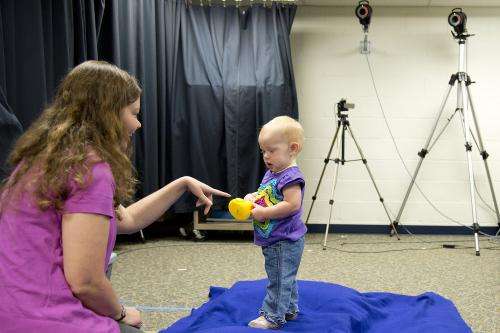Babies learning to stand more stable when holding object, study finds

(Medical Xpress)—Babies learning to stand may look wobbly, but they are really in more control than they appear, especially when they focus and hold on to an object like a toy, according to Purdue University research.
"Babies learning to stand often sway and appear out of control, but in this study, once we handed them a toy their standing posture improved and they were more stable," said Laura Claxton, an assistant professor of health and kinesiology who studies motor development in children. "Even though babies are top heavy and their neuromuscular systems are immature, this shows infants have more control when standing than many believe. Without the toy to hold, they go right back to being unstable."
The findings also support previous research that swaying, while it may look shaky, is another way babies explore the environment. Early instability is functional, Claxton said. Body sway provides sensory information that allows infants to learn how to appropriately control their body within their environments. However, too much body sway would make it impossible for the infants to focus on the toy, so Claxton believes that infants reduce their amount of sway in order to better interact with the toy.
"These babies are shifting their postural strategies in a manner that helps them accomplish their immediate goals of either exploring the environment or engaging with a toy," Claxton said. "They may look unsteady, but they are strategically adapting their behavior."
The findings are published in the September issue of the Journal of Experimental Child Psychology. The 16 babies, averaging 11 months old, in the study were independently standing but not yet walking. Their standing time, movement and stability when holding and not holding a toy was measured as they stood on a force plate. Video recordings also were used to compare movements captured by the force plate and the focus of the baby's attention.
"We are interested in whether this is a learned behavior or innate," Claxton said.
It also could be that this posture control is learned when infants learn to independently sit or that their development systems adapt so quickly in just a few days of standing independently.
To answer these questions, long-term studies are needed to follow babies from sitting to standing and to walking to understand the continuum of motor development.
"Standing is not an easy task as babies learn to balance with a small base of support in relationship to their bodies, and it really says something about their development that the skill improves when they multi-task," she said. "This work doesn't take place in a clinical setting, but research about infant and child motor development can ultimately help professionals monitor children's growth and help develop therapies and assistance when there are problems."
Claxton also is comparing these results to how babies alter posture and stability while fixating on pictures. She also will extend this work to children who have difficulties with their balance, such as children with cerebral palsy and Down syndrome.
More information: The control of posture in newly standing infants is task dependent, Laura J. Claxton, Dawn K. Melzer, Joong Hyun Ryu, Jeffrey M. Haddad, Journal of Experimental Child Psychology.
ABSTRACT
The postural sway patterns of newly standing infants was compared under two conditions: standing while holding a toy and standing while not holding a toy. Infants exhibited a lower magnitude of postural sway and more complex sway patterns when holding the toy. These changes suggest that infants adapt postural sway in a manner that facilitates visually fixating on and stabilizing the toy in their hand. When simply standing, infants exhibited postural sway patterns that appeared to be more exploratory in nature. Exploratory sway patterns may allow infants to learn the affordances of their new standing posture. These results demonstrate that newly standing infants are capable of task-dependent postural control.

















